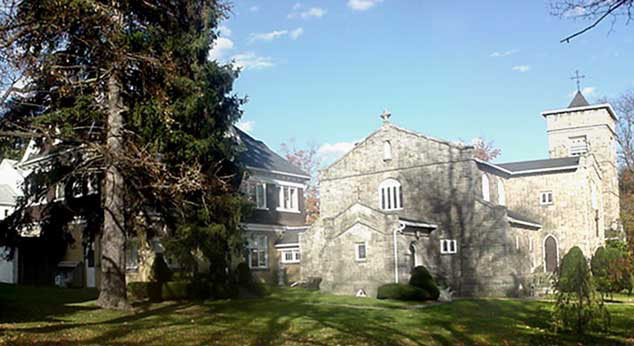|
St. Luke's Consecrated
McKean County Miner
Smethport Pa, Sept. 16, 1892
The St. Luke's Church, designed by W.
Halsey Wood, is of the 14th century English Gothic style of architecture,
with low pitched roofs covering the nave and transept. The latter, which
forms a conspicuous break in the southern wall of the nave is to be used
as a chapel, called St. Margaret's, has a high clerestory and a large
window of richly colored glass placed well up in the gable end.
At the south east corner of the building is placed a square battemented
tower, 17x17 feet in width, walls 2 1/2 feet thick. There are two
porches, the one in the tower measuring 9x10 feet, the other at the west
end 10x12feet.
Besides the central passage-way, there are two aisles on the north and
south sides of the church, with massive brick columns supporting the arches,
also of brick, between the aisles and the nave. The clerestory windows
are placed up from the point of the nave arches and afford a quaint bit
of coloring to the the richly tinted glass which is set deep into thick
brick jambs. The altar and reredos are raised to a proper height
at the east end of the church, set out from the wall, and built in connection
with a screen forming an ambulatory at the back and a passage way
from the yestries which are placed on the right and left of the
chancel. The screen is built of cream colored brick divided into
deep gothic panels. The altar and reredos are of cain stone and
are strictly in accordance with the style of the building. The front
of the altar, which is 9 feet 3 inches long, is divided into three recessed
arched panels, almost as deep as the altar is wide. The interior
is filled with stone, well cemented, so that it is in fact a solid mass
of stone. The mensa or altar slab is one piece of pure white marble.
The reredos is also of Caen stone formed in 3 niches, surmounted by a
delicately carried canopy, which is very beautiful.
The altar and reredos were given as a memorial, the steps of light colored
Tennessee marble bearing the following inscription: "To the
Glory of God. In memory of Orlo James Hamlin and Orra Lucinda Hamlin."
The credence table and sedalia seats are built into the wall by means
of arches and are made a prominent feature of the interior of the church.
All the walls are plastered and painted with soft golden colors ( exceptthose
of the aisles which are olive) in broad tints without stenciling; while
the door and window jambs and string courses are built solid of cream
colored brick. The massive roof timbers are bolted together with
simplicity, while the ceilings throughout are of yellow pine.
The flooring under the seats is of oak. The central passage-way,
the aisles, the choir and sanctuary are tiled. The aisles are filled
with cream colored tile with a border of red and black. The
tilling of the choir and sanctuary is of the same colors, but laid
in rich patterns of ecclesiastical form. A beautiful wood screen
of oak, divides the nave from the chancel. The choir stalls and
pews are also of oak. Standing neat the west door is a large, handsome
Font of Caen stone, the cover of which is of oak and brass; cut in the
base of the Font is the following inscription: :In loving memory of Rachel
Niles and Ada, children of D.C. and Ada M. Young."
There are many other offerings, indeed most of the furnishings of the
church are gifts from members of the parish, and from others having strong
ties of early association with St. Luke's. A full list will be given
later. No one could fail to notice the entire harmony existing between
the building and its furnishments, which is owing to the fact that almost
everything placed in the church was manufactured from special designs
prepared by the noted architect to whose professional skill not only St.
Luke's parish but every citizen of smethport, is indebted for the possession
of a gem of a building a perfect specimen of an English Gothic Church.
The Character of the church can be fitly expressed in three words:
Solidity, simplicity, dignity.
To Hon. Henry Hamlin, we take this occasion to express the gratitude of
the entire people of smethport irrespective of religious predilections,
for having erected this magnificent Church edifice. The money that
Judge Hamlin has so lavishly appropriated within the past few years in
beautifying out town, is appreciated much more by the citizens than he
realizes. All wish him and his family many blessings for the interest
they have taken in the common welfare and happiness of the people.
McKean County Miner Smethport Pa, Sept. 16,
1892
|



